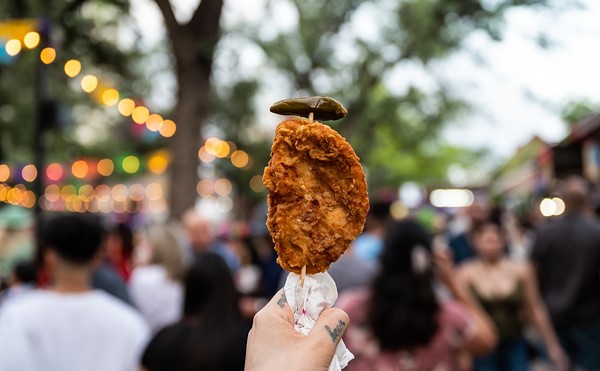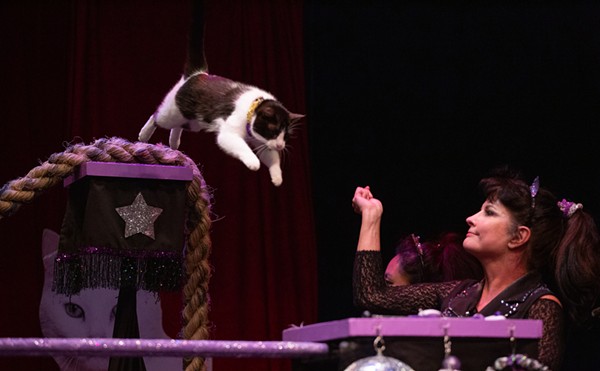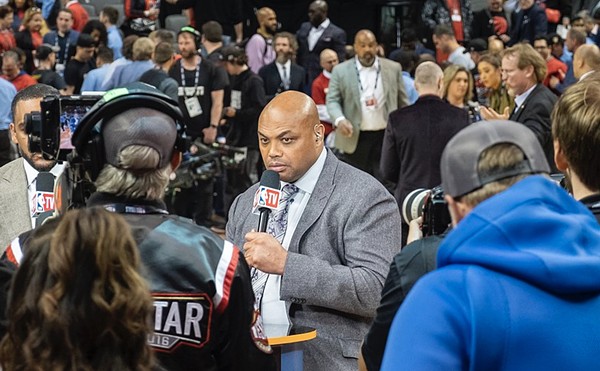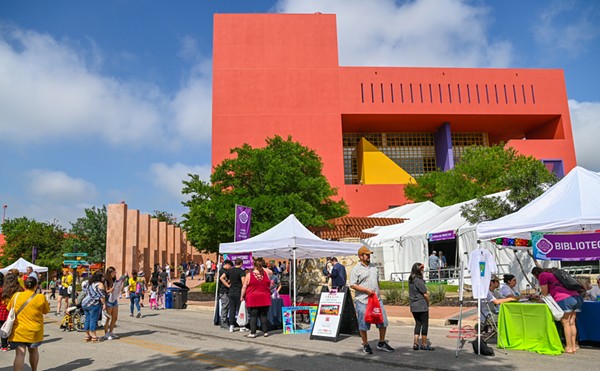When Museo Alameda opened its doors in April, 2007, as an affiliate of the Smithsonian Institute, it was the realization of a dream for many artists in San Antonio. Though the City of San Antonio turned over city property to house the Museo and continues to help fund the effort through the Office of Cultural Arts, the operation has been on a downward slide almost from the beginning. Directors have come and gone and community support has dwindled amidst rumors of fiscal mismanagement and impending lawsuits. The Museo has no endowment fund and is sinking in debt. Faced with bankruptcy, the Museo was partially bailed out when the City assumed operational costs 18 months ago. A year and a half later, the City is once again taking extraordinary measures to prop up the floundering museum. Even though the Museo botched its proposal for 2012 funding from the Office of Cultural Affairs, receiving a dismal score 10 points below the minimum threshold of 75 in its presentation to OCA’s Cultural Arts Board (CAB) panel, they’re still in the money. The other 10 applicants who failed to make a passing score this year aren’t so lucky, but last week OCA recommended that $150,000 in unallocated funds from OCA’s 2012 budget, paid for by the Hotel Occupancy Tax, should go to the chronically challenged institution. Last Friday, City Council approved that recommendation as part of the next city budget. The Museo is likely to receive yet more financial assistance from the city. The Memo of Understanding agreed to 18 months ago that established that the city would assume the running costs of the city-owned property that houses the Museo in Market Square expires September 29, but is expected to be renewed, once again using the city’s Market Square fund to cover the Museo’s rent and utilities expenses. Not everyone is happy with the state of affairs, and the money is just the half of it.
Founded in 1995 as the Alameda National Center for Latino Arts and Culture, the Museo was part of a master plan that included the restoration of the iconic Alameda Theatre as part of the mission to “tell the story of the Latino experience in America through art, history, and culture.” The fundraising drive to accomplish the Center’s many goals was headed up by philanthropist Henry Muñoz III, now CEO of Kell Muñoz Architects, Inc., the largest minority-owned architectural firm in Texas. Muñoz served as first chairman of Alameda, Inc., the Center’s umbrella organization. Other supporters included Rosemary Kowalski, owner of prestigious catering firm the RK Group, and George Cortez, owner of Mi Tierra Restaurant & Bakery in Market Square. Since the opening four years ago, there have been some strong shows at the Museo, like Phantom Sightings, a traveling show organized by the Los Angeles County Museum of Art, and a Jesse Treviño retrospective curated by Ruben C. Cordova, recently of UTSA, but many weak ones, too. But before the Museo existed, there were dreams.
George Cortez calls the room upstairs in the building he owns on the corner of Commerce Street and Santa Rosa Avenue “The White Castle,” because the white-walled room has been the headquarters for much dreaming about what the West End, the neighborhood around the old market square, could become. Over the years the White Castle has served as an art studio and hangout for a group of friends that included artists, musicians and others that became part of Cortez’ circle. In 1994, a group of Chicano artists that included Jesse Treviño, César Martinez, Mel Cassas, and Rolando Briseño met with Cortez to discuss something they all had wanted, seemingly, for forever: a museum to show work by San Antonio artists. Meeting with them was Miguel Bretos of the Smithsonian Institute, who Briseño, recently returned to SA from the East Coast, had known in New York. Bretos described the lack of Latino presence in cultural institutions through out the U.S. as “willful neglect,” something that the Latino community would have to change themselves. “We wanted to build a bridge to the Anglo side,” Cortez said last Thursday. “Not to take away from anything, but to contribute to the San Antonio art scene.”
His father, Pedro Cortez, started what became Mi Tierra Restaurant & Bakery in 1941 with three tables at the city’s fruit and vegetable market. When the produce brokers moved away to Zarzamorra Street, the emptied neighborhood went into recession. But the plummeting land prices allowed Pedro Cortez to buy up much of the property, including half of the old mercado. As his family prospered, Cortez said he began to wonder, “What is my life about? We wanted to know what we should do as a familia.” The answer, he believed, was to turn Market Square and surroundings into the zona cultural, a cultural zone that would protect the heritage of the old neighborhood. In the early 1990s, a group called the Friends of the Alameda — named after the old Alameda Theater in the neighborhood that had once been the largest movie house in the country to screen Spanish-language films — was formed to try to make it happen. Cortez says that in the old days the neighborhood wasn’t exclusively Mexican, but “the Ellis Island of San Antonio. There was a thriving Jewish business community,” that “Germans, Czechs, and Lebanese worked the Mercado along with Mexicans and everyone else.” When Henry Munuz III joined the effort in 1995, the group was formally organized as Centro Alameda, now a 501(c)3 nonprofit.
Yet once realized, problems started that have grown with time. After years of dubious management, increasing debt, and increasing disfavor among many past supporters, Rolando Pablos was asked by the Cortez family to try to solve the mess at the Museo. “Everyone criticizes, but no body wants to step up to the plate. That’s key,” Pablos, chairman of Centro Alameda, Inc., told the Current last Friday after securing a financial commitment from the City. “Everybody is asking me to go defuse the bomb, then they tell me I’m not defusing it the right way.” Pablos has made some severe changes since he became chairman of the Museo’s umbrella organization 14 months ago. A past chairman of the San Antonio Hispanic Chamber of Commerce and the presiding officer of the Texas Racing Commission until six months ago, Pablos, who is also SA’s honorary council to Spain, describes himself as “an attorney with a business passion who is stepping up.”“Why is the Museo taking a nose-dive? It’s a combination of two things. Number one, the master fundraiser (Muñoz) left to do other things, and two, we were trying to be too many things,” Pablos said. “We were trying to be a theater developer, a museum operator, and a landlord.” The under-financed organization has divested itself of two of three properties, the classic Alameda Theatre movie-house and the Henry Ford Academy housed in the old Casa de Mexico International building. Both the school and the theater are now managed by their own 501(c)3 organizations. And the Museo’s staff, which ran at 30 in its first year, has dwindled down to only four. The only person who has any art experience is the interim director, Guillermo Hoyos, who has run commercial art galleries in Mexico City. No one on staff has previous museum experience. Though Pablos has curtailed expenses and dealt with what could be seen as mission creep during his tenure, some in the arts and nonprofit community fear that the Museo is suffering from mission drift.
One of the reasons that the Museo received a failing grade in their CAB review is that only a single exhibition, Tequila, the Spirit of Mexico, is planned for the coming year. Nine shows were presented in the first year. The following year, eight were shown, last year, there were only two exhibitions.
Tequila will follow Revolution & Renaissance: Mexico & San Antonio 1910-2010, which has been on view since last November, when the Museo reopened after six months closure. Revolution & Renaissance, consisting of historic artifacts and art loaned from the collection of San Antonio’s Aaron family, used Pablos’ formula of relying on outsourced talent like James Oles, the show’s curator, to mount the exhibition. The show, which will remain on view through October, was a rare birthday wish to Mexico during that nation’s centennial year when much of the United States was falling into xenophobia and pursuing anti-immigrant laws like Arizona’s notorious SB1070. Though he attended St. Mary’s, where he received both his BA and later, his law degree, and has lived on the city’s Westside, Pablos said: “I was born and raised in Mexico, so I’m very sensitive to all of that because I’m an immigrant myself.”
The only other show at the Museo in 2010 was a modest tribute to Manny Castillo, the founder of San Anto Cultural Arts and the Westside community mural project. Organized in-house, the Manny show featured many local artists who had painted murals under his direction. The show’s curator, Rigoberto Luna, joined his brother Ruben, a long-time preparator at the Museo, in quitting the Museo shortly after the exhibition opened. Rigoberto Luna is now volunteering as the graphic designer and publicity coordinator for San Anto Cultural Arts. The show was the last hurrah of the Museo’s old guard.
An announcement for the tequila show proclaims that it will “shed unprecedented light on the arts and culture of Mexico and San Antonio in its continuing effort to tell the story of the Latino experience in the Americas.” Perhaps the copywriter was a bit sloppy with the wording, but the message skews a bit from the Museo’s mission statement that appears on their 990 tax forms, “To tell the story of the Latino experience in America through art, history, and culture.” America or the Americas, what’s the difference?
I mentioned to Pablos that presenting a single exhibition about tequila, even if the show focused on the culture surrounding the Mexican icon, was still a unique focus on Mexico and seemed to stray from the mission to present “the Latino experience in America.” His response was swift, reflecting that he was aware of the criticism I had heard from others.
“Come on, cut to the chase,” Pablos said, “you want a Chicano museum. Don’t hide behind the term “Latino” when you really mean Chicano — civil rights — all those things.“
Pablos said that the tequila show is not intended to solve all the museum’s problems in one swoop (fears of creditors taking the Alameda to court, for instance, may require much more). But choosing tequila as the only obvious response to a host of ills is a dubious remedy. Meanwhile, Pablos, a Republican, won’t be sitting put to see it through. He told the Current he plans to join Texas Governor and presidential candidate Rick Perry on the campaign trail next month, though he promises to continue as chairman and that Guillermo Hoyos, the Museo’s director, will remain in charge of day-to-day business. On Tuesday he was named by the Governor’s Office a commissioner of the Public Utility Comission.
Museums don’t just make aesthetic judgments. They’re professional and business operations too.
The American Association of Museums lists many institutional members on its database, including in SA the National Skeet Shooting Hall of Fame and Museum. Of the estimated 17,500 museums in country, only 778 are AAM accredited, a two-year process of self-study and peer review in a number of categories that include public programs, fulfillment of mission, facilities maintenance, financial management, collection stewardship, and long-ranch strategic planning.
It’s not cheap, and it’s hard to achieve, but simply initiating the process is a great aid to educating a museum’s board and management team. AAM accreditation is a necessity to receive some exhibition loans, and while not required by the City, accreditation greatly improves chances of receiving grants from other funders. In SA, the Witte, McNay Art Museum, and San Antonio Museum of Art have all achieved accreditation. In response to a query from the Current, the Institute of Texan Cultures, the other Smithsonian affiliate in town, responded that they had completed the AAM Museum Assessment Program self-study last year and are positioning themselves for “the next round of evaluations.” Bully for them. However, Dewey Blanton, director of strategic communications for AAM said the Museo “has never been accredited, and is not now in the process.”
When asked if the Museo had asked OCA for assistance with mentorship to enter the AAM process, the director Felix Padrón responded, “No. That has never come up in this office.”
Maybe the Museo’s new leadership will be successful in meeting their goals without the input of their peers. At least they are more realistic in stating the Museo’s financial needs, having more than doubled the annual budget to $4 million. George Cortez understands the risks. He remarked: “Keeping the museum alive is vital to the community, but it will only succeed if San Antonio artists are there. People come here to see our art, not New York artists. But I don’t foresee that it will be easy. We need to do a balancing act.”
Choosing the hope for financial stability found in one blockbuster show while continuing the long walk away from the city’s artists (and standard museum management) is a perilous game, however. How will the Museo gain respect and trust from possible future financial donors, including commercial sponsors like the tequila industry now in their sights, if they don’t have museum professionals on staff? Even if outsourcing professionals does make the tequila show possible, why would the city, and its people, want a second museum that looks only to Mother Mexico for inspiration? The Instituto Cultural de México in Hemisfair Park is just blocks away. •
















